Page 63 of 489

62 Safety and SecurityOccupant safetyIn this section you will learn the most im-
portant facts about the restraint system
components of the vehicle.�
Seat belts (
�page 69)
�
Child restraints (
�page 82)
�
Lower anchors and tethers for children
(LATCH) (
�page 83)
Additional protection potential provide
�
Supplemental Restraint System (SRS)
with�
Air bags (
�page 63)
�
Air bag control unit (with crash sen-
sors)
�
Emergency tensioning device (ETD)
for seat belts (
�page 72)
�
Active head restraints (
�page 73)Air bag system components with
�
Front passenger front air bag off indica-
tor lamp (
�page 81)
�
Front passenger seat with Occupant
Classification System (OCS)
(�page 77)
As independent systems, their protective
functions work in conjunction with each
other.The SRS system conducts a self-test when
the ignition is switched on and in regular
intervals while the engine is running. This
facilitates early detection of malfunctions.
The
1
indicator lamp in the instrument
cluster comes on when the ignition is
switched on and goes out no later than a
few seconds after the engine has been
started.
The SRS components are in operational
readiness if the
1
indicator lamp is not
lit when the engine is running.
A malfunction in the system has been
detected if the
1
indicator lamp:
�
fails to go out after approximately four
seconds after the engine was started
�
does not come on at all
�
comes on after the engine was started
or while driving
iFor information on infants and children
traveling with you in the vehicle and
restraint systems for infants and chil-
dren, see “Children in the vehicle”
(�page 74).
Page 88 of 489
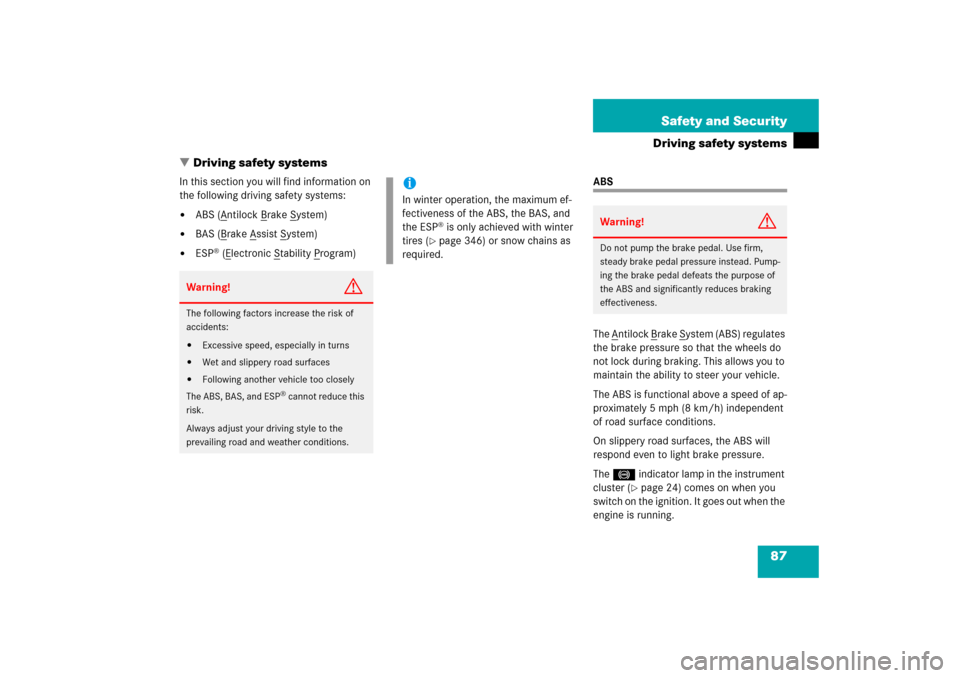
87 Safety and Security
Driving safety systems
�Driving safety systems
In this section you will find information on
the following driving safety systems:�
ABS (A
ntilock B
rake S
ystem)
�
BAS (B
rake A
ssist S
ystem)
�
ESP
® (E
lectronic S
tability P
rogram)
ABS
The A
ntilock B
rake S
ystem (ABS) regulates
the brake pressure so that the wheels do
not lock during braking. This allows you to
maintain the ability to steer your vehicle.
The ABS is functional above a speed of ap-
proximately 5 mph (8 km/h) independent
of road surface conditions.
On slippery road surfaces, the ABS will
respond even to light brake pressure.
The - indicator lamp in the instrument
cluster (
�page 24) comes on when you
switch on the ignition. It goes out when the
engine is running.
Warning!
G
The following factors increase the risk of
accidents:�
Excessive speed, especially in turns
�
Wet and slippery road surfaces
�
Following another vehicle too closely
The ABS, BAS, and ESP
® cannot reduce this
risk.
Always adjust your driving style to the
prevailing road and weather conditions.
iIn winter operation, the maximum ef-
fectiveness of the ABS, the BAS, and
the ESP
® is only achieved with winter
tires (
�page 346) or snow chains as
required.
Warning!
G
Do not pump the brake pedal. Use firm,
steady brake pedal pressure instead. Pump-
ing the brake pedal defeats the purpose of
the ABS and significantly reduces braking
effectiveness.
Page 91 of 489
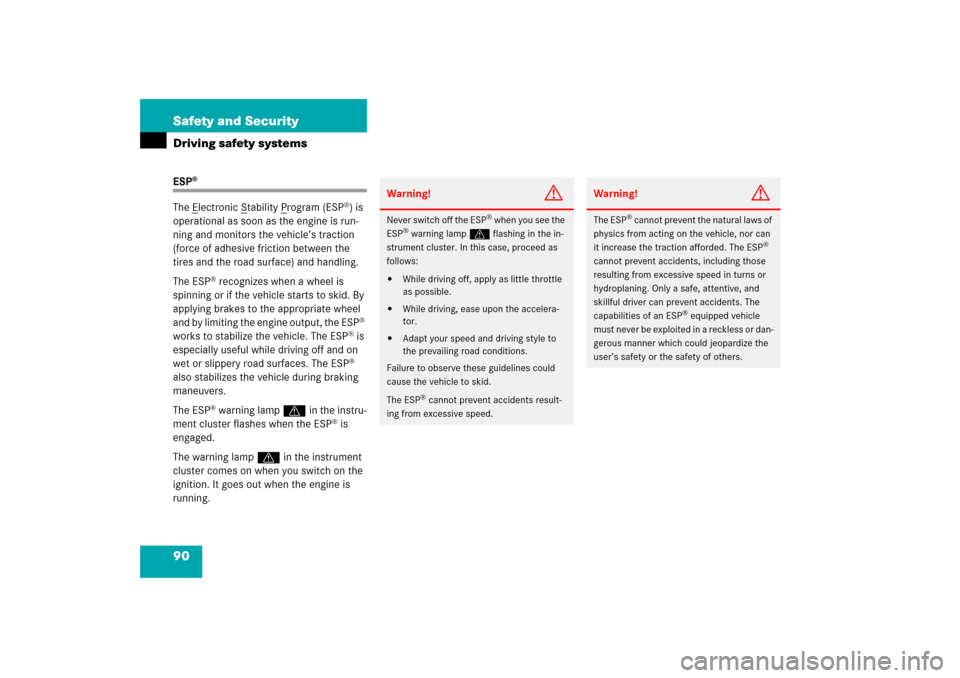
90 Safety and SecurityDriving safety systemsESP
®
The E
lectronic S
tability P
rogram (ESP
®) is
operational as soon as the engine is run-
ning and monitors the vehicle’s traction
(force of adhesive friction between the
tires and the road surface) and handling.
The ESP
® recognizes when a wheel is
spinning or if the vehicle starts to skid. By
applying brakes to the appropriate wheel
and by limiting the engine output, the ESP
®
works to stabilize the vehicle. The ESP
® is
especially useful while driving off and on
wet or slippery road surfaces. The ESP®
also stabilizes the vehicle during braking
maneuvers.
The ESP
® warning lamp v in the instru-
ment cluster flashes when the ESP
® is
engaged.
The warning lamp v in the instrument
cluster comes on when you switch on the
ignition. It goes out when the engine is
running.
Warning!
G
Never switch off the ESP
® when you see the
ESP
® warning lamp v flashing in the in-
strument cluster. In this case, proceed as
follows:
�
While driving off, apply as little throttle
as possible.
�
While driving, ease upon the accelera-
tor.
�
Adapt your speed and driving style to
the prevailing road conditions.
Failure to observe these guidelines could
cause the vehicle to skid.
The ESP
® cannot prevent accidents result-
ing from excessive speed.
Warning!
G
The ESP
® cannot prevent the natural laws of
physics from acting on the vehicle, nor can
it increase the traction afforded. The ESP
®
cannot prevent accidents, including those
resulting from excessive speed in turns or
hydroplaning. Only a safe, attentive, and
skillful driver can prevent accidents. The
capabilities of an ESP
® equipped vehicle
must never be exploited in a reckless or dan-
gerous manner which could jeopardize the
user’s safety or the safety of others.
Page 94 of 489
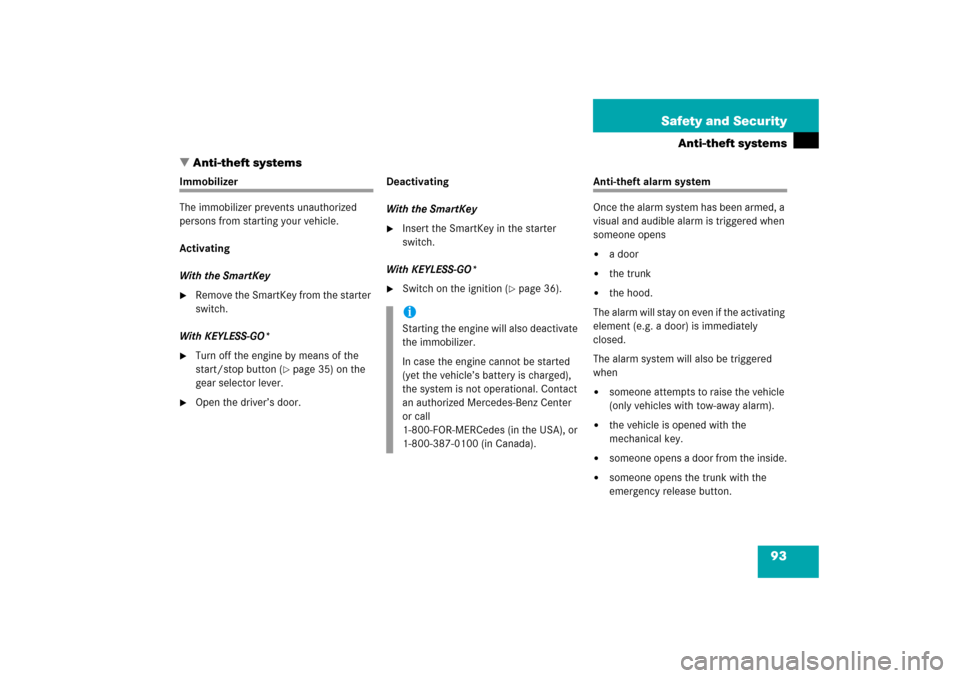
93 Safety and Security
Anti-theft systems
�Anti-theft systems
Immobilizer
The immobilizer prevents unauthorized
persons from starting your vehicle.
Activating
With the SmartKey�
Remove the SmartKey from the starter
switch.
With KEYLESS-GO*
�
Turn off the engine by means of the
start/stop button (
�page 35) on the
gear selector lever.
�
Open the driver’s door.Deactivating
With the SmartKey
�
Insert the SmartKey in the starter
switch.
With KEYLESS-GO*
�
Switch on the ignition (
�page 36).
Anti-theft alarm system
Once the alarm system has been armed, a
visual and audible alarm is triggered when
someone opens�
a door
�
the trunk
�
the hood.
The alarm will stay on even if the activating
element (e.g. a door) is immediately
closed.
The alarm system will also be triggered
when
�
someone attempts to raise the vehicle
(only vehicles with tow-away alarm).
�
the vehicle is opened with the
mechanical key.
�
someone opens a door from the inside.
�
someone opens the trunk with the
emergency release button.
iStarting the engine will also deactivate
the immobilizer.
In case the engine cannot be started
(yet the vehicle’s battery is charged),
the system is not operational. Contact
an authorized Mercedes-Benz Center
or call
1-800-FOR-MERCedes (in the USA), or
1-800-387-0100 (in Canada).
Page 97 of 489
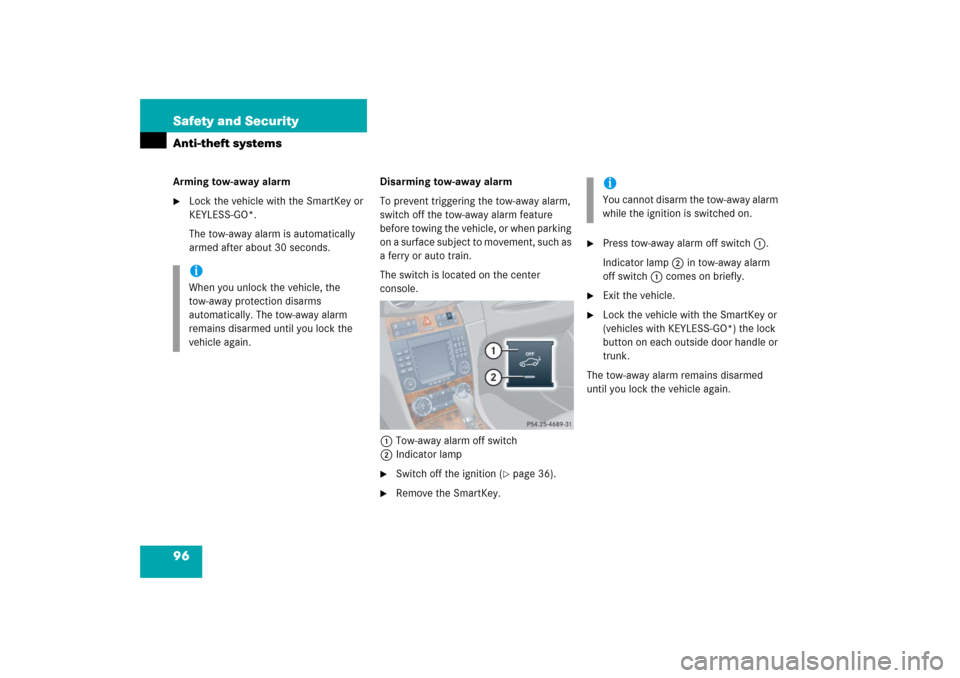
96 Safety and SecurityAnti-theft systemsArming tow-away alarm�
Lock the vehicle with the SmartKey or
KEYLESS-GO*.
The tow-away alarm is automatically
armed after about 30 seconds.Disarming tow-away alarm
To prevent triggering the tow-away alarm,
switch off the tow-away alarm feature
before towing the vehicle, or when parking
on a surface subject to movement, such as
a ferry or auto train.
The switch is located on the center
console.
1Tow-away alarm off switch
2Indicator lamp
�
Switch off the ignition (
�page 36).
�
Remove the SmartKey.
�
Press tow-away alarm off switch1.
Indicator lamp2 in tow-away alarm
off switch1 comes on briefly.
�
Exit the vehicle.
�
Lock the vehicle with the SmartKey or
(vehicles with KEYLESS-GO*) the lock
button on each outside door handle or
trunk.
The tow-away alarm remains disarmed
until you lock the vehicle again.
iWhen you unlock the vehicle, the
tow-away protection disarms
automatically. The tow-away alarm
remains disarmed until you lock the
vehicle again.
iYou cannot disarm the tow-away alarm
while the ignition is switched on.
Page 121 of 489

120 Controls in detailLocking and unlocking�
Close the trunk (
�page 113).
�
Pull the mechanical key out of the
SmartKey (
�page 404).
�
Insert the mechanical key in the trunk
lid lock.
�
Turn the mechanical key clockwise to
position2 and remove the mechani-
cal key in that position to lock the
trunk.
The trunk remains locked even when the
vehicle is centrally unlocked.
�
Insert the mechanical key in the trunk
lid lock.
�
Turn the mechanical key counterclock-
wise to neutral position1 and remove
the mechanical key in that position to
unlock the trunk.
You can now open the trunk
(�page 111).
Automatic central locking
The doors and the trunk automatically lock
when the ignition is switched on and the
wheels are turning at vehicle speeds of
approximately 9 mph (15 km/h) or more.
You can open a locked door from the
inside. Open doors only when conditions
are safe to do so.
You can deactivate the automatic locking
mode using the control system, see “Set-
ting automatic locking” (
�page 163).
iYou can only cancel the separate trunk
locking mode by means of the
mechanical key.
iThe doors unlock automatically after an
accident if the force of the impact
exceeds a preset threshold.
To prevent the vehicle door locks from
locking, deactivate the automatic
central locking when the vehicle�
is pushed or towed
�
is on a test stand
��
Page 126 of 489
125 Controls in detailSeats
Multicontour seat*
The multicontour seat has a movable seat
cushion and inflatable air cushions built
into the backrest to provide additional
lumbar and side support.
The seat cushion movement, backrest
cushion height and curvature can be
continuously varied with switches on the
side of the seat after switching on ignition.
1Seat cushion depth
2Backrest bottom
3Backrest center
4Side bolster adjustment
�
Switch on ignition (
�page 36).Seat cushion depth
�
Adjust the seat cushion depth to the
length of your upper leg using
switch1.
Backrest contour
�
Adjust the contour of the backrest to
the desired position using switches2
and3.
Backrest side bolsters
�
Adjust the backrest side bolsters so
that they provide good lateral support
using switch4.iIf, after a period of time, the seat no
longer provides the desired contour,
then repeat the adjustment procedure.
Page 127 of 489
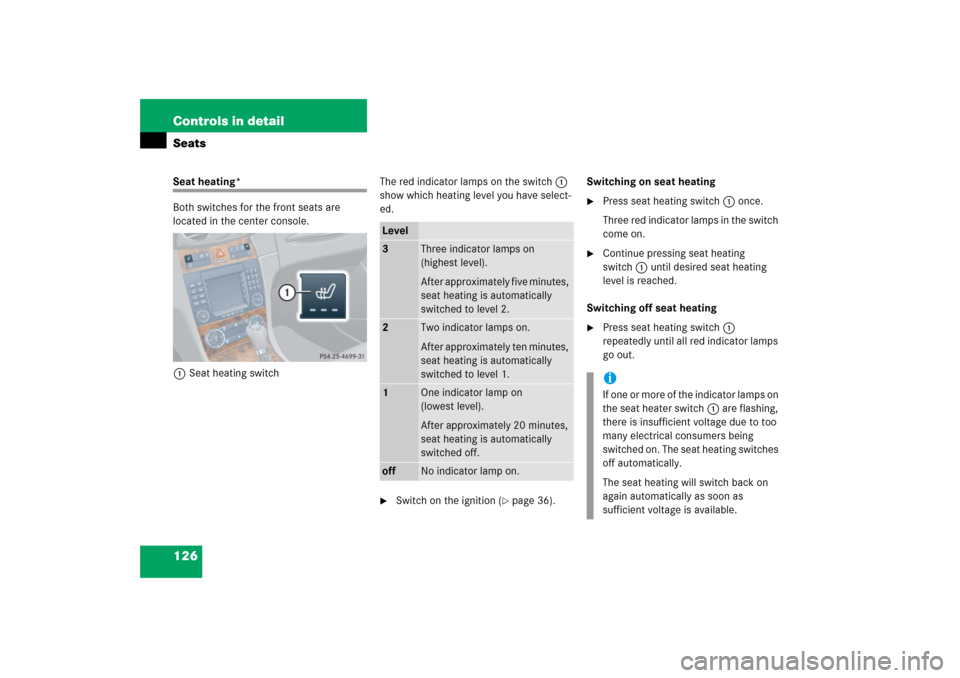
126 Controls in detailSeatsSeat heating*
Both switches for the front seats are
located in the center console.
1Seat heating switchThe red indicator lamps on the switch1
show which heating level you have select-
ed.
�
Switch on the ignition (
�page 36).Switching on seat heating
�
Press seat heating switch1 once.
Three red indicator lamps in the switch
come on.
�
Continue pressing seat heating
switch1 until desired seat heating
level is reached.
Switching off seat heating
�
Press seat heating switch1
repeatedly until all red indicator lamps
go out.
Level3
Three indicator lamps on
(highest level).
After approximately five minutes,
seat heating is automatically
switched to level 2.
2
Two indicator lamps on.
After approximately ten minutes,
seat heating is automatically
switched to level 1.
1
One indicator lamp on
(lowest level).
After approximately 20 minutes,
seat heating is automatically
switched off.
off
No indicator lamp on.
iIf one or more of the indicator lamps on
the seat heater switch1 are flashing,
there is insufficient voltage due to too
many electrical consumers being
switched on. The seat heating switches
off automatically.
The seat heating will switch back on
again automatically as soon as
sufficient voltage is available.